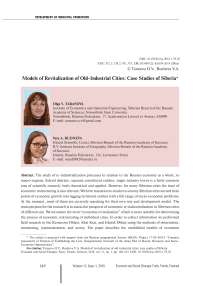Models of revitalization of old-industrial cities: case studies of Siberia
Автор: Tarasova Olga V., Rudneva Vera A.
Журнал: Economic and Social Changes: Facts, Trends, Forecast @volnc-esc-en
Рубрика: Development of municipal formations
Статья в выпуске: 1 (55) т.11, 2018 года.
Бесплатный доступ
The study of re-industrialization processes in relation to the Russian economy as a whole, to macro-regions, federal districts, separate constituent entities, single-industry towns is a fairly common area of scientific research, both theoretical and applied. However, for many Siberian cities the issue of economic restructuring is also relevant. With the transition to market economy Siberian cities turned from points of economic growth into lagging territorial entities with a full range of socio-economic problems. At the moment, most of them are currently searching for their own way and development model. The main purpose for the research is to assess the prospects of economic re-industrialization in Siberian cities of different size. We introduce the term “economic revitalization” which is more suitable for determining the process of economic restructuring of individual cities. In order to collect information we performed field research in the Kemerovo Oblast, Altai Krai, and Irkutsk Oblast using the methods of observation, monitoring, systematization, and survey...
Old industrial city, economic revitalization, case study, triple helix, interaction, single-industry town, science city, cluster
Короткий адрес: https://sciup.org/147224015
IDR: 147224015 | УДК: 332.1; | DOI: 10.15838/esc.2018.1.55.10
Текст научной статьи Models of revitalization of old-industrial cities: case studies of Siberia
In the late 19th century in the South of Siberia large enterprises started mining and processing of coal; later, they engaged in production of ferrous and nonferrous metals, agriculture was rapidly developing. Since the 1930–s, intensive industrialization has contributed to a significant influx of the population, economic diversification, and the rising living standards. Siberia is currently an important element of the Russian economy (Siberian Federal district comprises more than 10% of GRP).
With the transition to market economy in the 1990–s, cities and towns experienced a sharp decline in the pace of socio-economic development: they tuned from points of economic growth into lagging municipal units with a full range of socio-economic problems and limited means and powers to reach sustainable growth. At the moment, most of them are still searching for a way to achieve it, choosing a model of development.
The main purpose for the study is to assess the prospects for economic reindustrialization in Siberian cities of different size1.
To achieve this goal, the following objectives are addressed:
-
1. Identify the features of studying the prospects for reindustrialization at the city level.
-
2. Choosing case cities of Siberian reindustrialization and primary collection of data on their socio-economic development.
-
3. Complex field studies to obtain in-depth information about the state of the economy in the settlements. Systematization and analysis of the obtained data.
-
4. Description and schematic representation of urban development models indicating close interaction between the participants and identification of an initiative leader in the restructuring process.
-
5. Identification of models’ common features and their weaknesses ensuring the basis for acceleration of the economic development.
-
1. Research methods.
The study of reindustrialization processes in terms of the Russian economy as a whole [1, 2], the economy of macro-regions [3], federal districts [4], individual regions [5, 6], singleindustry towns [7, 8, 9] is a fairly common area of scientific research, both theoretical and applied. The number of research works dedicated to the study of reindustrialization of Russian cities (the existing ones are not very extensive [10, 11] and focus on world experience without application to specific objects), despite the generally recognized significant role of large and medium-sized cities in the socio-economic development of territories. However, the issue of economic restructuring is very relevant to many Siberian cities.
Traditionally, a set of policy documents operating in the territory serves as an important source in such studies. However, practice shows that documents of the highest level do not often have sufficient detail in terms of describing the implementation mechanisms and the documents of the municipal level are outdated or absent. The amount and quality of statistics on basic indicators of socio-economic development of settlements are also insufficient to understand the essence, build models of development or identify its bottlenecks.
A set of works on the prospects of development of Russia’s single-industry towns serves as a starting point for the authors to formulate the research methodology. For example, the “Basic element” [7] is based on the field method of collecting information (indepth interviews) and analysis of statistical data. To solve the problem of single-industry towns “Basic element” offers three typical models: controlled compression, sustained single-industry town, industrial diversification. In order to classify the town in this or that development model it is offered to take into account the condition and development plans of a city-forming enterprise. The roles of administration and research and educational complex are put in the background. On the contrary, N.Yu. Zamyatina and A.N. Pilyasov [9] in their work pay special attention to the role of knowledge infrastructure in the development of Russian single-industry towns. At the same time, the authors recognize that the role of the administrative resource in the formation of the new industrial policy and removal of development locks is also significant. The work by V.V. Didyk and L.A. Ryabova [8] classification of eight single-industry towns in the Murmansk Oblast is carried out considering the leading actor in the implementation of complex investment plans of the cities: federal and regional government, city-forming business or small business. The present work considers a different structure of participants: business (large, medium, small), the state (municipal, regional and federal authorities), research and educational complex. The interaction of a similar triplex of actors is considered by the developers of the reindustrialization program of the Novosibirsk Oblast in the article [6].
In order to study the existing models and collect relevant information on Siberian cases of reindustrialization, in July 2015 and July 2016, expeditions were undertaken in central and southern regions of the Kemerovo Oblast, south-western regions of Altai Krai, northern regions of the Irkutsk Oblast with the participation of the authors. During the field research methods such as observation, monitoring, systematization, and surveys were used. The team members held meetings with heads of administrations of municipal units (MU), managers and employees of large industrial enterprises, conducted interviews with local residents, representatives of small and medium businesses in the area territory study.
The research results are presented in the form of case studies of five settlements in Siberia (cities of Novokuznetsk, Bratsk, Biysk, Usolye-Sibirskoye town and Sheregesh rural settlement) with the use of comparative analysis on an equal basis with the practice of Russian and foreign scholars (see, for example, [12]; [13, pp. 70–73]). The description of the development models is based on the concept of a triple helix with selecting the key actor, as well as an indicating close interaction of the government, business and the scientific community in the territory.
Case study is a common method of studying the processes and mechanisms of territory’s restructuring. Thus, one of the works [14] describes the transformation of Pittsburgh steel industry amid extremely tense environmental conditions into a center of high-quality medicine, education, nanotechnology, and financial services. Other works [15, 16] analyze the transformation of textile Manchester into a cradle of cultural life through the reconstruction of urban areas, development of creative industries, and modernization of the transport infrastructure. The success of Emscher Park – the symbol of the new economy of cities in the Ruhr Area (once the center of coal and steel industry in Europe) – is explained by the following factors [17]: the initiators and executors of numerous projects were commercial companies, non-profit organizations, as well as residents of the region who independently attracted the necessary resources. The state mainly performed the coordinating function.
Taking into account the peculiarities of Russia and Siberia in particular, it should be noted that the use of best foreign practices for managing the development of old industrial territories is possible only to a limited extent. An integral part of each strategy is the implementation of transport, housing and environmental projects aimed at improving the quality of life in the city abroad [8], while in Russia the emphasis is put on the prospects of the city-forming enterprises, their investment plans, social responsibility, liabilities to production diversification [18] or their preservation.
Research results
The settlements under study are old industrial: their parent enterprises have functioned for a long time (Tab.) and require technical, ideological and social modernization.
Primary comparison of case cities
Indicator Novokuznetsk Bratsk Biysk Usolye-Sibirskoye Sheregesh Status Single-industry town - Science city Single-industry town Single-industry town Population as of 01.01.2016, people 551 253 234 147 203 826 78 569 10 101 Population trend for 25 years Decline Decline Decline Decline Rise Budget revenues in 2015, million rubles 18 094 5 542 3 001 1 350 75.2 Year of establishment of major industries Late 19th century 1955–1966 1942–1991 1936–1983 1952–1981 Branch specialization Non-ferrous metallurgy Power engineering, non-ferrous metallurgy, pulp and paper Chemistry, tool engineering, pharmaceuticals Chemistry Ferrous metal extraction, tourism Source: compiled from: Russian regions. Socio-economic indicators, 2016. Federal State Statistics Service. Available at: ru/bgd/regl/b16_14t/ (Accessed: 12.10.2017); data from field research.
Since the settlements of old industrial territories do not always have sufficient resources to carry out large-scale reindustrialization, we assume that Siberian urban settlements should apply specific development models – model of revitalization.
Revitalization is the process of “reviving” the economy by opening up new opportunities for traditional forms of management within the framework of the existing sectoral structure taking into account their modern functions (social, innovation, integration). It is a “softer” technique and a less extensive process than reindustrialization [19].
The Table demonstrates that the territorial formations under study differ in scale, status, and branch specialization. According to the research hypothesis, the issues of economic development and ways to solve them in the context of modernization of economic systems and reindustrialization are likely to be different.
At the same time, territorial proximity opens up opportunities for these issues to be jointly addressed, as well as maximum use of synergy of space [20].
Case “City of Novokuznetsk”
The existing revitalization model in the city can be called “Industrial diversification” ( Fig. 1 ).
The key economic actors in the city are large metallurgical enterprises. Their development strongly depends on the policy of the central administration of the holding company, in particular, on its strictly set framework for the expenditure level. At the same time, considerable pressure is also put on by the administration of the city and the region. As a result, the city-forming enterprises explicitly perform the social function. The enterprise administration maintains the policy of jobs even taking into account the projected loss of commercial effect.
Figure 1. Model of industrial diversification of the city of Novokuznetsk
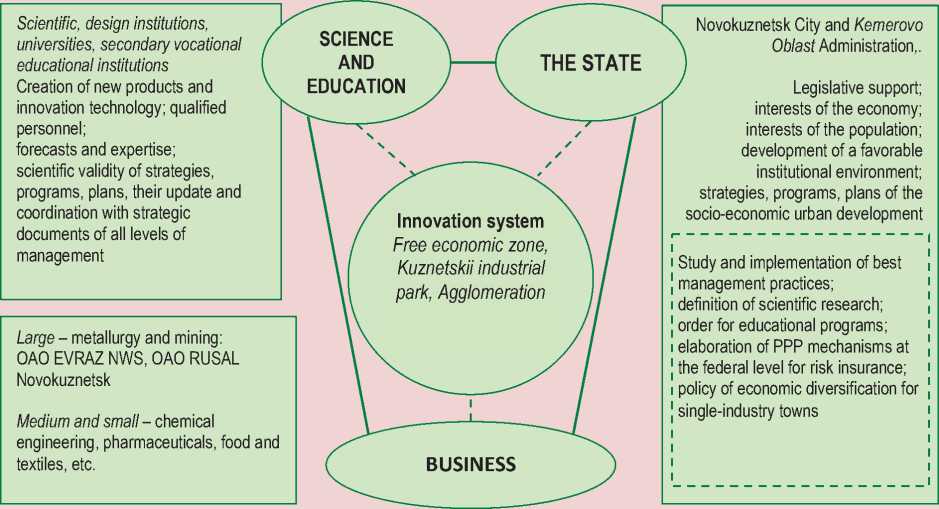
Source: compiled by the authors.
In some cases, the process of technological modernization of industrial enterprises takes place under the pressure from the city administration rather than with the aim of reducing costs. For example, OOO RUSAL Novokuznetsk has implemented a program to improve energy efficiency of the enterprise, put into operation a closed water supply system, etc.
Product diversification within firms is influenced by global market conditions. As a result, the dependence of income on the world market and the corresponding risks for enterprises increase. Business representatives believe there are opportunities of using the mechanism of public-private partnership (PPP) in the field of sharing these risks.
One of the major directions of The Comprehensive Program of Social and Economic Development of Novokuznetsk up to 2025 is the diversification of the sectoral structure of the economy. It should include the development of existing non-core industries mainly by small and medium businesses. The most promising areas are technological waste processing, energy, constructions, innovation-driven mechanical engineering, and food industry. The following projects have been implemented: ferroalloy production, recycling of waste from magnetic ore separation, production of marketable fire-resistant products from fire-resistant waste, etc. At the same time, the administration notes that, unfortunately, the bank of real projects aimed to significantly change the situation in the near future is extremely small.
There is a shortage of technical specialists in the city. At the moment the most important role in training personnel belongs to major enterprises themselves. They implement training programs, internships; acquire specialized sponsored classes in major educational institutions. A special place in the personnel policy belongs to large-scale competitions among the employees such as “Project 250|, “RUSAL Professional”, corporate championship of professional skill standards WorldSkills held at EVRAZ NorthWestern Smelter (NWS) which we visited during field research. In the long term, with support from the city administration the following mechanism should operate: market needs – secondary vocational education – higher educational institution.
A specific feature of the model is intensive yet clear pairwise interactions between the administration, science and business. The city’s innovation system is weak as it does not involve all three elements at the same time.
In our opinion, the role of the “Science and education” unit in personnel provision, development and implementation of innovative products and technology, project examination, and forecasting should be significantly increased.
Case “City of Bratsk”
The main types of industrial production in the city are metallurgy and pulp and paper formed on its own natural resource base. The energy sector is also of great importance.
The established model of revitalization is titled “Innovative diversification of the city of Bratsk” ( Fig. 2 ). It involves all 3 institutions (the state, business, and science and education complex) which form the image of current economy due to productive capacity of the existing enterprises and the innovation support infrastructure.
Giant enterprises (Bratsk Hydroelectric Power Station, Bratsk Aluminium Smelter, Bratsk LPK (forest industry complex)) constantly upgrade their technological capacity by introducing innovative technologies mainly supplied by Bratsk State University
Figure 2. Model of innovative diversification of the city of Bratsk
Bratsk City, Irkutsk Oblast
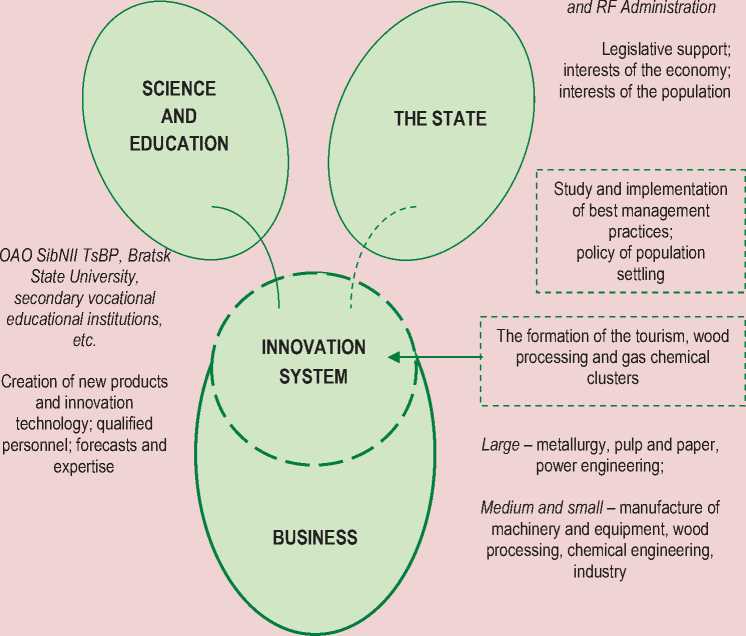
Source: compiled by the authors.
and OAO SibNII TsBP (Siberian Forest and Paper Research Institute) [21]. Most of the products of large enterprises are focused on the foreign market and are, accordingly, developing within the framework of the global environment increasing the burden on the city’s environment2.
Extraterritorial interests of the owners of key related businesses forming a single economic complex, the variety of tools for redistributing the effects within corporate structures, their non-transparent activities often lead to infringement of regional and public interests.
Searching for mechanisms to regulate the activities of large companies in resource regions such as the one under study is a very urgent issue. The solution should be developed with the participation of the scientific complex.
Large enterprises of Bratsk industrial hub are quite stable, carrying the social burden to some extent. The key enterprises have spare capacities which could be used for new processing projects related to promising projects in neighboring regions (Nizhnee Priangar’e region, projects of the Sakha (Yakutia) Republic). At the same time, however, there is no progress towards strategic cooperation either at the level of production facilities or at the level of municipal units.
The city of Bratsk lags behind other cities of the region in terms of development of the service sector and, accordingly, small business. When it comes to the socio-economic development, a special place is given to large and medium businesses. The city has more than 20 investment projects (industrial production, medicine, tourism, transport infrastructure, etc.) and most of them are under implementation3.
Bratsk actively works on increasing its investment attractiveness, creating a bank of projects, and platforms for their promotion. From the point of view of the strategic vision of the city’s own development, the authorities point to the need for a planned objective anticipated at the level of the national economy. Starting from the regional and even municipal levels, it is difficult to draw up such an objective, especially in terms of assessing the capabilities of the neighboring regions and schedule compliance. Having not received the status of the Priority Social and Economic Development Area (TOSER), the municipal authorities of the Northern regions of the Irkutsk Oblast led by Bratsk still do not give up this idea completely.
The problems of the forest industry are particularly relevant for the region under study. Restoration of forests is carried out too slowly (less than 10% of the cutting area), related industries are not being developed (the plywood manufacturing plant of Bratsk LPK is partially sold, the rest is not functioning), major industry actors are lobbying to reduce the minimum age of cutting from 102 years to 60, which, obviously, will accelerate the depletion of the resource base.
The survey conducted among young people confirmed the highly relevant problem of preserving the population in the territory. Most of respondents prefer to live in another major city (Novosibirsk, Krasnoyarsk, Saint Petersburg) rather than in Bratsk. Almost all students who participated in the survey have friends or acquaintances who decided to move from Bratsk. As a rule, the age of those who decide to move is between 18 and 25 years, they have higher education and move to continue their studies or find a better paid job; 40% of respondents are going to leave Bratsk in the next one or two years [22]. The elaboration of a set of measures to keep young people in the city taking into account the preferences highlighted in the survey should become one of the priorities of municipal and regional authorities.
The city has a well-coordinated system of training in local universities and secondary vocational educational institutions depending on the needs of the city’s leading enterprises.
Despite the intense pair-wise connections of the model blocks, the innovation system is not institutionally designed. The peculiarity of the model is the relative independence of large business.
Case “City of Biysk”
The scientific complex of Biysk was formed in the 1950-s after the establishment of large industrial defense enterprises in the city. In the 1990-s, the absence of state defense orders caused increased unemployment and a decline in the population’s standard of living. In this regard, in the post-reform period the sphere of small and medium businesses became increasingly important, the wholesale and retail network as the main sphere of population’s employment began to develop. At the same time, the primacy of the research and manufacturing complex (RMC) remains:
industry is mostly represented by enterprises manufacturing science-intensive products. This feature, as well as the efforts of the city administration made it possible fro Biysk to become one of Russia’s science cities in 2005. The administration’s work is aimed at preserving this status, studying the paths of development and using the experience of other science cities in the country.
The revitalization of Biysk economy is realized within the framework of the classical model of “triple helix” [23]. It involves all three key institutions – the state, business, science and education – in close cooperation. The natural leader in Biysk is the science and education complex ( Fig. 3 ).
The city of Biysk has a fairly diverse economy and has succeeded in creating clusters of small and medium enterprises. In the post-
Soviet period, large state-owned enterprises in the city were divided into many small ones, many of which soon ceased to exist. The survived and new businesses merged on a voluntary basis.
In 2008, a non-profit organization (NPO) Altai biopharmaceutical cluster was established. The main activities of the cluster members are chemical and pharmaceutical production, biopharmaceuticals, production of food products with specified useful properties and production of medical equipment. The organization of more than 35 participants operates on its own raw materials, seeking to implement the maximum processing chains within the cluster.
At the beginning of 2015, Altai polymer composite cluster NPO was established. Its activity is mainly aimed at the development and
United in a cluster: large – defense, pharmaceuticals, chemical engineering, tourism
Figure 3. Model of development of the science city of Biysk
Research institutions, higher educational institutions, secondary vocational educational institutions, etc.
Creation of new products and innovation technology; qualified personnel; forecasts and expertise;
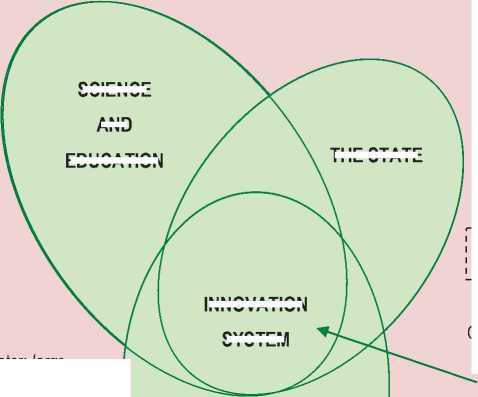
SCIENCE
AND
THE STATE
EDUCATION
INNOVATION
SYSTEM
Biysk City, Altai Krai, and RF Administration
Study and implementation of best management practices; legislative support; interests of the economy; interests of the population
Policy of population settling
Biysk business incubator, ОАО Altai Federal Research-and-Production Center, Altai biopharmaceutical cluster NPO, Altai polymer composite cluster NPO
Source: compiled by the authors.
CLUSTERS
BUSINESS
Operate beyond a cluster: medium and small – wholesale and retail trade, agriculture, machine building

Creation of an industrial park, development of exiting and formation of new clusters
industrial production of composite materials and products used in constructions, power engineering, mineral extraction, and housing and utilities. The Russian market of polymer composite materials is in its infancy but its sharp increase is projected (up to 10 times by 2020) with an emphasis on domestic consumption.
Inside the clusters there is a system of training, employees annually receive international certificates, competitions to support individual initiatives (Umnik (Smart Guy)) and educational programs for beginner entrepreneurs are held. At the same time, the policy of keeping young population is poorly elaborated at the municipal level: the city administration does not arrange doors open days, career fairs which could really (taking into account the timetable) be attended by school students. This is a weak point of the current model of the science city development.
Business incubators are available in almost all industrial parks in the world. At the same time, a business incubator is a kind of superstructure serving the needs of residents of an industrial park. In Biysk, a business incubator exists separately (since 2012) performing the same functions for “free” small business. The local administration and RMC have not yet been able to implement a project to create an industrial park.
In our opinion, amid specific conditions of Biysk it is possible to create an international industrial park similar to Suzhou Industrial Park (China) [24].
Over the past 10 years, the attitude towards tourism as a significant area of economic diversification has changed significantly for the better. The administration has developed a project of the auto-tourist cluster “The Golden Gate” which is currently going through the process of concept approval and organizational and financial elaboration. The cluster project implies the implementation the following activities based on PPP: construction of domestic infrastructure facilities, a tourist information center, trade enterprises, two motorway service complexes, a recreation centre, catering facilities, collective accommodation facilities including a roadside inn, a motel and small luxury hotels, camping with facilities (toilets, showers, kitchens). In addition to this, it is recommended to restore old buildings in the city center or develop abandonment tourism4.
In the transport sector, the emphasis should be put on improving the capacity of the transport network, as well as ensuring adequate access to remote areas of the city. It is necessary to join the Chinese project on renewal and operating of the Silk Road (China – Mongolia – Russia). It should be noted that China in this project focuses on high technology (innovation) and Biysk can offer them.
Case “Usolye-Sibirskoye town”
The dominant branch of the city is chemical industry (up to 60%) whose importance significantly reduced since 2013 as the cityforming enterprises such as OOO Usol’ekhimprom and OOO Usol’e-Sibirskii Silikon ceased their production operations. The program of the city’s socio-economic development up to 2017 implies the formation of a chemical and pharmaceutical cluster; however, none of the four potential production initiatives has been established yet. Apart from creating new industries there is a need to modernize the existing enterprises. This would solve a number of economic and environmental issues in the city.
In the framework of measures to support single-industry municipal units in Russia in 2016 a mixed-type PSEDA was established. It currently involves one resident – Dega-Irkutsk industrial park. It will be mainly focused on innovation activities (center for 3D printing and prototyping, projects to develop and implement IT and robotics). It is planned to create clusters of woodworking, consumer goods and mechanical engineering. Another PPP project is planned in the framework of the program of import substitution in Russia: AO Farmasintez plans the construction of a plant to produce active pharmaceutical ingredients at PSEDA Usol’e-Sibirskoe which will be produced using its own raw materials5.
The development of the city is carried out within the framework of the model of innovation and industrial diversification according to the triple helix of interaction. Its distinctive negative feature is a small share of scientific participation due to the fact that there are no large research institutes and universities in the city (Fig. 4).
The city’s system of strategic planning is based on medium–term plans which do not specify the main strategic development objective – innovative diversification.
The major deterrent to development is the outflow of the local population and the shortage of highly qualified personnel for new production. The local administration carries out a number of programs on training, retraining and advanced training of the population [25]. Due to proximity to the administrative center of the region one should rely on its educational potential.
Figure 4. Model of innovation and industrial diversification in Usol’e-Sibirskoe
Branches of research institutions, higher educational institutions; scientific production association secondary vocational educational institutions, etc. Creation of new products and innovation technology;
qualified personnel; forecasts and expertise;
Large – chemical engineering, pharmaceuticals;
Medium and small – tool
engineering, food and light industry, constructions
SCIENCE
AND
EDUCATION
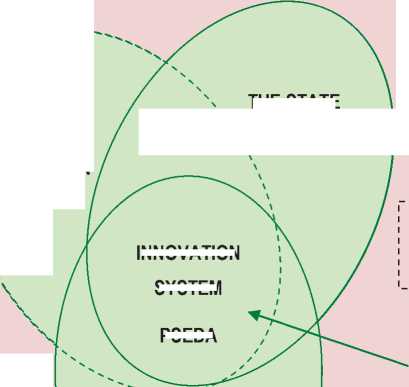
INNOVATION
SYSTEM
Study and implementation of best management practices; policy of population settling
Dega-Irkutsk industrial park; formation of the chemicalpharmaceutical cluster
Legislative support; interests of the economy, interests of the population
Usolye-Sibirskoye
Administration, Irkutsk Oblast and RF administrations
THE STATE
PSEDA

Formation of clusters of wood processing, light industry and machine building
Source: compiled by the authors.
Case “Sheregesh rural settlement”
The main economic activities of the rural settlement involve mining and tourist and recreational activities.
Sheregesh has implemented a model of a double helix of interaction between the government and business ( Fig. 5 ). Business invests in modernization and diversification of the economy and the government is engaged in social aspects: choosing socially responsible partners, improving the investment environment, forming a favorable institutional environment, etc.
Currently, the Gornaya Shoriya branch of OAO Evrazruda is developing an eponymous iron ore deposit and supplying it to the plants in Novokuznetsk. The work and plans of this city-forming enterprise are mostly defined outside the settlement – the parent company is located in Novokuznetsk. The requirements of the holding to the level of profitability led to the launch of the reconstruction project:
the company will completely switch to a new ore mining technology with the use of high-performance self-propelled equipment. The implementation of the project will also partially reduce the severity of the personnel problem.
Due to natural and climatic conditions in the settlement it became possible to create a new major industry based on the development of the Sheregesh winter tourist resort. In the early 1990–s, the demand for domestic tourism increased and Sheregesh initiated active development of the tourist infrastructure: construction of modern hotels, development of new mountain ski routes. The creation of the road to the resort in 2011 significantly improved its transport and geographical position. In order to increase the investment attractiveness, all new tourist facilities will be included in the economic zone with preferential tax treatment (the Gornaya Shoriya free economic zone of tourist and recreational type was created in 2010). At the moment, the
Figure 5. Model of the double helix interaction in Sheregesh rural settlement
Environmental policy in tourism; transparent system of strategic planning; creation of a favorable institutional environment for business development; legislative support


Innovative investment projects; financial recourses
THE STATE
Administration of Sheregesh rural settlement, Tashtagol'skii Region ,Kemerovo Oblast and RF Administration
Interests of economy; interests of the population
BUSINESS
Large: mining
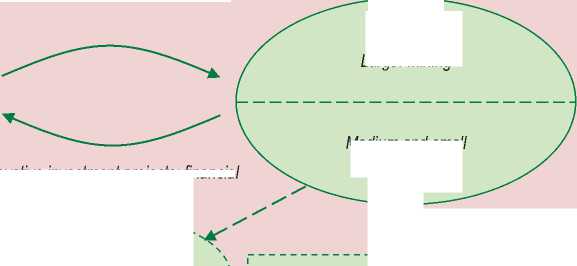
Trends to unite for obtaining the agglomeration effect
Space for cooperation, cluster initiatives
Medium and small
Creating a favorable environment, cluster policy
Source: compiled by the authors.
development of the resort and bringing it to the international level is a point of growth not only in the whole Tashtagol district, but also in the Kemerovo Oblast6. This is why it is included in the analysis.
The development of the ski resort puts high infrastructural demands. It is necessary to maintain the quality of the roadway of transport approaches to the resort, expand the network of accommodation infrastructure, provide housing and communal services in connection with the growing fund of hotels, cafes, saunas, provide a sufficient quantity of rental services. At the same time, there is a particularly pressing issue of using the created capacities during the summer period. According to the district administration, the workload of hotels in the summer is maximum 23%; the flow of tourists is reduced to 7% from the stress period in the winter. Thus, the revenues in the industry are currently subject to seasonality, the ways of using the infrastructure in the summer are not fully elaborated. In order to reduce the dependence of industry revenues on seasonality we propose to develop the following types of tourism in the village: recreational, sports, industrial, business, as well as cross-cutting tourism in cooperation with the Republic of Altai, Altai Krai, and the Republic of Khakassia. The administration of the settlement should play a significant role (initiative, consolidating) in the development of the tourism cluster. Effective marketing, work on consolidation of interests, involvement of foreign partners and consultants, study of the Russian and international experience (South Africa, France, Turkey, the USA, Krasnodar Krai, the Samara Oblast, Northern Caucasus) [26, 27] are also the success factors. In the context of limited financial resources, it is required to intensify cooperation with the regional administration regarding the promotion of the ski resort.
Intensive development of the new industry is complicated by staffing shortage: attracting the necessary number of qualified specialists will be extremely difficult taking into account the current level of the settlement’s development and its living conditions.
At the same time, the administration faces the challenge of organizing work with small businesses: it requires identification of common interests and their consolidation. After all, taking into account the specific features of tourism it is fair to rely on small and medium business. Large network business is away from the settlement’s projects. This is partly due to lack of information about the opportunities, partly due to the non-transparency of the business environment. The authorities point to a large number of concomitant issues of small business expansion, for example, entrepreneurs’ mass tax evasion, land manipulations, and unfair competition. There is currently no experience in dealing with such issues.
It should be noted that the system of strategic planning in the settlement is not structured: documents are not drafted, the website only demonstrates individual investment projects (information on which is not always updated).
In this case, the block “Science and education” is not included in the revitalization model as it only indirectly participates in the economic modernization (through the training system beyond the municipal unit). The prospects for including the block in the model consist in the development and application of a systematic approach to the problems of regulation of small and medium business taking into account the specific features of tourism.
Conclusion
The settlements of old industrial territories do not always have sufficient resources to carry out large-scale reindustrialization. So far, they have formed rather sustainable models of revitalization, i.e. economic revival.
The following aspects are common to the distinguished models of urban development:
-
1. The economy is highly dependent on major enterprises whose interests are often extra-territorial.
-
2. The issue of preserving the population and improving the quality of human resources is acute.
-
3. The economy is highly dependent on the situation at individual markets.
-
4. Lack of resources to perform the functions of managing the socio-economic development is associated with an imbalance between the obligations and powers of local authorities and budget revenues.
-
5. The attitude to PPP is restrained. In the settlements under study, economic agents consider PPP primarily as a tool as a mechanism to ensure stability, rather than initiate and/or intensify work on projects. Municipal and regional powers and resources are often not enough to remove or separate the existing risks, so it is necessary to strengthen the role of the federal center.
-
6. The mechanism of interaction between administrations and small businesses is not sufficiently developed. In all municipal units the respondents pointed to the absence of an organizational and legal mechanism of influence on the size of the shadow economy. With the exception of Biysk, small business support is targeted and insufficient to achieve the goals of economic diversification.
-
7. The municipal units’ level of activity regarding the study of best practices of territory management is different. With the exception of
-
8. The existing potential of inter-municipal interactions is practically not realized. It is possible to elaborate through tourist routes instead of splitting tourist flows amid tough competition. It is also advisable to establish cooperation in pharmaceuticals: organization of inter-municipal and inter-regional value added chains will reduce the dependence on imports of raw materials in the main cluster of Biysk.
Biysk, the interest in inter-municipal comparisons is minimal. It is recommended to join one or more associations such as the Association of Siberian and Far Eastern Cities, the Association of Small Tourist Cities, and the Association of Small and Medium-Size Cities to study best practices of municipal management.
The bottleneck of all models is lack of consolidation of interests and intensity of interactions.
In general, the certainly new author’s comprehensive approach to the study of the development models formed during the field research from the point of view of key participants’ interaction mechanisms help identify the bottlenecks of development, opened up the opportunity to develop recommendations to accelerate the processes of economic revitalization of the settlements under study.
The presented institutional models with their identified problems and proposed solutions can be used in strategic planning at the municipal level, in developing and updating concepts and programs, elaborating drafts of inter-regional agreements. Taking into account the leadership of an particular institutional participant of the revitalization process, as well as close interaction between them, can significantly adjust the mechanisms for achieving the goals of socio-economic development set in the policy documents. The vicinity factor of case-cities under study points to potential opportunities for intensifying intermunicipal interactions.
The research materials are included in the training courses on Regional Economics and a special course “Siberia in the system of state regional economic policy” taught within Bachelor’s programs at the Department of Economics of Novosibirsk State University and at the Department of Geology of Irkutsk State University.
The prospects for further research are seen in the expansion of the field of revitalization cases. This will help develop a network of possible inter-municipal and interregional interactions, ensuring the socio-economic development of cities and regions in Siberia. Monitoring revitalization processes in the already studied settlements would help assess the sustainability of the existing models and identify the factors with the strongest impact on their institutional transformation.
Список литературы Models of revitalization of old-industrial cities: case studies of Siberia
- Belozerova S.M., Bushmin E.V., Burlachkov V.K. et al. Reindustrializatsiya ekonomiki Rossii v usloviyakh novykh ugroz .Moscow: Rossiiskii ekonomicheskii universitet im. V.G. Plekhanova, 2015. 72 p.
- Bodrunov S.D., Grinberg R.S., Sorokin D.E. Reindistrialization of the Russian economy: imperatives, potential, risks. Ekonomicheskoe vozrozhdenie Rossii=Economic revival of Russia, 2013, no. 1 (35), pp. 19-49..
- Anokhov I.V. Bratsk-Ust-Ilimsk TPC as a reference point for re-industrialization of Siberia. Vestnik UrFU: Ekonomika i upravlenie=Bulletin of Ural Federal University. Series Economics and Management, 2017, vol. 16, no. 1, pp. 8-26..
- D'yachenko O.V., Zarubezhnov E.S. Reindustrialization of the Urals Federal District industry. Novyi universitet: Ekonomika i parvo= New University: Economics and Law, 2016, no. 11-1 (69), pp. 23-32..
- D'yachenko O.V. Re-industrialization of Chelyabinsk region economy. Vestnik Chelyabinskogo gosudarstvennogo universiteta=Bulletin of Chelyabinsk State University, 2015, no. 8 (363), pp. 92-103..
- Kuleshov V., Seliverstov V. Science, state, business -the triangle of reindustrialization. V mire nauki=In the world of science, 2016, no. 6 (special issue), pp. 9-15..
- Basic element. Single-industry towns. Reboot. Available at: http://www.basel.ru/monogoroda (Accessed: 27.04.2017)..
- Didyk V.V., Ryabova L.A. Single-industry towns of the Russian Arctic: development strategy on the case study of the cities/towns in the Murmansk Oblast. // Ekonomicheskie i sotsialnye peremeny: fakty, tendentsii, prognoz=Economic and social changes: facts, trends, forecast. 2014. № 4. P. 84
- Zamyatina N.Yu., Pilyasov A.N. Innovatsionnyi poisk v monoprofil'nykh gorodakh: blokirovki razvitiya, novaya promyshlennaya politika, plan deistvii . Moscow: LEAND, 2015. 216 p.
- Afanas'ev K.S. Reindustrializatsiya v sovremennom gorode: varianty i modeli . Key messages of reports at an international scientific conference: 21st readings from Tsarskoe Selo, Saint Petersburg, 21-22 April, 2015. Vol.1, pp. 236-239.
- Pechatkin V.V. Reindustrialization of cities of Russia: key problems and ways of their solving (on the example of Ufa). Fundamental'nye issledovaniya= Fundamental research, 2016, no. 6-1, pp. 202-206..
- Granberg A., Artobolevskaya S., Kovaleva G., Rossel' E. Restructuring of old industrial regions: world's and Russia's experience. Regional'noe razvitie i sotrudnichestvo=Regional development and cooperation, 1998, no. 1-2, pp. 4-23..
- Hill F. Sibirskoe bremya. Proschety sovetskogo planirovaniya i budushchee Rossii . Translated from English. Moscow: Nauchno-obrazovatel'nyi forum po mezhdunarodnym otnosheniyam, 2007. 328 p.
- Detrick S The Post Industrial Revitalization of Pittsburgh: Myths and Evidence. Community Development Journal, 1999, no. 1(34), pp. 4-12.
- Dicken P Global Manchester: from globaliser to globalised. In City of Revolution: Restructuring Manchester, 2002. Available at: https://www.research.manchester.ac.uk/portal/en/publications/global-manchester-from-globaliser-to-globalised(9bf1bac7-b30e-4f0b-8938-5a72ee1d1fa3).html (Accessed: 02.05.2017)
- Koutský J., Slach O., Boruta T. Restructuring Economies of Old Industrial Regions -Local Tradition, Global Trends, 2011. Available at: http://conference.osu.eu/globalization/publ2011/166-173_Koutsky-Slach-Boruta. pdf (Accessed: 28.04.2017)
- Schreckenbach C., Teschner C. IBA Emscher Park -a beacon approach, dealing with shrinking cities in Germany. 2006. Available at: https://ru.scribd.com/document/14741581/Industrial-Re-use-in-Germany (Accessed: 02.05.2017)
- Lobodanova D.L. Development strategies of old industrial cities. Voprosy ekonomiki=Economic issues, 2014, no. 4, pp. 56-76..
- Shenshinov V.Yu. Revitalization of industrial enterprises as an innovative area of modern economic development. Vestnik Altaiskoi Akademii ekonomiki i prava=Bulletin of Altai Academy of Economics and Law, 2010, no. 4, pp. 26-28..
- Pilyasov A.N. (Ed.). Sinergiya prostranstva: regional'nye innovatsionnye sistemy, klastery, peretoki znaniya . Smolensk: Oikumena, 2012. 760 p.
- Zabortseva T.I., Rudneva V.A. The transformation of the economy and population in the territory of the Irkutsk North (TIN) in the 21st century. Izv. Irkut. gos. un-ta. Ser.: Nauki o Zemle=The bulletin of Irkutsk State University: Series "Earth sciences", 2016, vol. 15, pp. 28-43..
- Tarasova O.V., Shevelev A.A., Ivanova V.V. The economy of the North of the Irkutsk Oblast and the Republic of Buryatia: progress or regression in the future. // Issledovaniya molodykh uchenykh: ekonomicheskaya teoriya, sotsiologiya, otraslevaya i regional'naya ekonomika= Studies of young scientists: economic theory, sociology, sectoral and regional economics, 2015, pp. 350-357..
- Fridman Yu.A., Rechko G.N., Oskina N.A. Regional'naya politika v Kemerovskoi oblasti pri razlichnykh modelyakh ekonomicheskogo razvitiya. // Subfederal'naya ekonomicheskaya politika: problemy razrabotki i realizatsii v Sibirskom federal'nom okruge . Novosibirsk: IEOPP SO RAN, 2012. Ch. 10, pp. 291-321.
- Hague C., Hague E., Breitbach C. Regional and Local Economic Development, Palgrave Macmillan, 2011, UK.
- Vinokurov M.A., Sukhodolov A.P. Goroda Irkutskoi oblasti . 2nd edition revised and updated. Irkutsk: BGUEP, 2011. 342 p.
- Aleksandrova A.Yu. The cluster principles in organization of the tourists' space (the world experience). Rol' turizma v modernizatsii ekonomiki rossiiskikh regionov=The role of tourism in modernization of the economy in Russian regions, 2010, pp. 21-27..
- Volkov S.K. Foreign and Russian experience in tourist cluster development. Nauchnye vedomosti Belgorodskogo gosudarstvennogo universiteta= Belgorod State University Scientific Bulletin, 2016, no. 16 (237), pp. 5-15..

